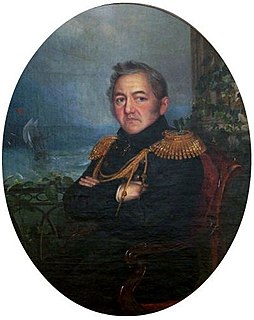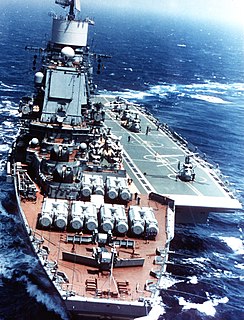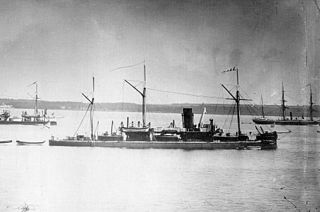
The Kirov class, Soviet designation Project 1144 Orlan, is a class of nuclear-powered guided missile cruisers of the Soviet Navy and Russian Navy, the largest and heaviest surface combatant warships in operation in the world. Among modern warships, they are second in size only to large aircraft carriers, and of similar size to a World War I era battleship. The Soviet classification of the ship-type is "heavy nuclear-powered guided missile cruiser". The ships are often referred to as battlecruisers by Western defence commentators due to their size and general appearance.

Pavel Stepanovich Nakhimov, one of the most famous admirals in Russian naval history, is best remembered as the commander of naval and land forces during the Siege of Sevastopol (1854-1855) during the Crimean War.

Admiral Mikhail Petrovich Lazarev was a Russian fleet commander and an explorer.

Admiral Flota Sovetskogo Soyuza Gorshkov (Russian: Адмира́л фло́та Сове́тского Сою́за Горшков "Admiral of the Fleet of the Soviet Union Gorshkov" was an aircraft carrier of the Soviet Navy and the Russian Navy from 1987 to 1996. The ship's original name was Baku when she was commissioned in 1987. Sometimes Admiral Gorshkov is considered a separate class due to her improvements including a phased array radar, extensive electronic warfare installations, and an enlarged command and control suite. She was launched in 1982, and was in service from 1987 to 1991 in the Soviet Navy as Baku, and from 1991 to 1996 in the Russian Navy as Admiral Gorshkov. In 2004, she was sold to India and converted into a STOBAR carrier now named INS Vikramaditya.

Kirov is the lead ship of the Kirov class of nuclear-powered missile cruisers. Originally built for the Soviet Navy, it was one of the biggest and most important surface combatants of the Russian Navy. It is similar in displacement to a World War I battleship. Although commissioned as a missile cruiser, Kirov's size and weapons complement have given her the unofficial designation of a battlecruiser throughout much of the world. The appearance of the Kirov class was a significant factor in the U.S. Navy recommissioning the Iowa class. She was named after a Project 26 cruiser.
The Russian and Soviet Navy's ship naming conventions were similar to those of other nations. A problem for the non-Russian reader is the need to transliterate the Cyrillic names into the Latin alphabet. There are often several different Latin spellings of the same Russian name.
Several Russian and Soviet warships were named Admiral Ushakov in honour of Fyodor Fyodorovich Ushakov:
Lazarev (masculine) or Lazareva (feminine) may refer to:

Admiral Lazarev was the second Kirov-class battlecruiser. Until 1992 she was named Frunze after a Project 68 cruiser ; at that time she was renamed after Russian admiral Mikhail Petrovich Lazarev. Scrapping of the ship began in April 2021.
At least five warships of Russia have borne the name Admiral Nakhimov, in honour of Pavel Nakhimov an admiral of the Imperial Russian Navy.

The Admiral Lazarev class was a pair of monitors built for the Imperial Russian Navy in the late 1860s, which designated them as armored turret frigates. Four ships were ordered, but the last two were significantly modified during construction and became the separate Admiral Spiridov class. The sister ships were assigned to the Baltic Fleet upon completion and remained there for their entire careers. Aside from one accidental collision, their careers were uneventful. They were reclassified as coast-defense ironclads in 1892 before they became training ships later that decade. The Admiral Lazarevs were stricken from the Navy List in 1907 and 1909; both were sold for scrap in 1912.

The Russian monitor Admiral Greig was the second and last of the two Admiral Lazarev-class monitors built for the Imperial Russian Navy in the late 1860s. She was assigned to the Baltic Fleet upon completion and remained there for her entire uneventful career. She was reclassified as a coast-defense ironclad in 1892 before she became a training ship later that decade. Admiral Greig was decommissioned in 1907, stricken from the Navy List in 1909 and scrapped in 1912.
6 ships of the Imperial Russian and Soviet Navies have been named Petropavlovsk after the 1854 Siege of Petropavlovsk.
At least five ships in the Imperial Russian, Soviet or Russian Navies have been named Varyag after the Varangian people, the Viking ancestors of the Rus.
Three ships of the Soviet Navy have been named Petropavlovsk after the 1854 Siege of Petropavlovsk.

The Russian monitor Admiral Lazarev was the name ship of her class of monitors built for the Imperial Russian Navy in the late 1860s. She was assigned to the Baltic Fleet upon completion and remained there for her entire career. Aside from one accidental collision in 1871, her service was uneventful. The ship was reclassified as coast-defense ironclad in 1892 and often served as a training ship. There was an unsuccessful proposal to convert her into an aircraft carrier in 1910. Admiral Lazarev was stricken from the Navy List in 1907 and sold for scrap in 1912. She sank while under tow to Germany later that year.
Three ships of the Soviet Navy have been named for the Bolshevik leader Mikhail Vasilyevich Frunze.
At least two warships of the Soviet Navy have borne the name Admiral Nakhimov, in honour of Pavel Nakhimov an admiral of the Imperial Russian Navy.
This page is based on this
Wikipedia article Text is available under the
CC BY-SA 4.0 license; additional terms may apply.
Images, videos and audio are available under their respective licenses.






